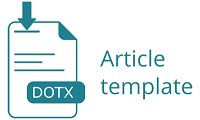Central Corneal Thickness in Ocular Hypertension Patients in Sanglah General Hospital Bali
Abstract
Ocular hypertension (OH) is a risk factor in glaucoma and modifiable in its early stages. Goldmann applanation tonometer (GAT) is still the gold standard in measuring intraocular pressure (IOP) which is an important parameter in diagnosing and managing glaucoma. Several factors can affect the accuracy of the GAT, one of them is the thickness of the central cornea. This descriptive study was intended to describe the central corneal thickness (CCT) characteristics of the OH patients. The study was conducted at Eye Clinic - Sanglah General Hospital Denpasar which involved 32 patients with 46 eyes diagnosed with HO in 2018. The mean age of subjects was 43.98 (± 17.92), men had a larger proportion (68.1 %). Sixty-six per cent of patients were diagnosed with bilateral OH. In this study, the mean central corneal thickness in HO subjects was 573.81 ± 33.46 μm. The patients' median vertical cup to disc ratio at the time of diagnosis was 0.33, with a mean visual acuity of 0.85. The median value of IOP at the first time of examination was 24.47 mmHg.Central corneal thickness is known to have a positive correlation with IOP, thus affecting the accuracy of IOP measurements. The thicker central corneal thickness will lead to overestimation of the IOP and the thinner one will cause underestimation.
Keywords
References
American Academy of Ophthalmology. (2017). BCSC: Glaucoma. San Fransisco: American Academy of Ophthalmology. p. 159- 163.
Anderson, D. R. (2016). IOP: The Importance of Intraocular. In J. A. Giaconi, S. K. Law, K. Nouri-Mahdavi, A. L. Coleman, J. Caprioli (Eds.), Pearls of Glaucoma Management. Berlin: Springer. p. 85-90.
Asia Pacific Glaucoma Society. (2016). Asia Pacific Glaucoma Guidelines. 3rd ed. Amsterdam : Kugler Publications, p.34.
Brandt JD, Gordon MO, Gao F, Beiser JA, Miller JP, Kass MA; Ocular Hypertension Treatment Study Group. Adjusting intraocular pressure for central corneal thickness does not improve prediction models for primary open-angle glaucoma. Ophthalmology. 2012;119(3):437-42. https://doi.org/10.1016/j.ophtha.2011.03.018.
Brandt, J. D. (2016). IOP: Central Corneal Thickness. In J. A. Giaconi, S. K. Law, K. Nouri-Mahdavi, A. L. Coleman, & J. Caprioli (Eds.), Pearls of Glaucoma Management. Berlin: Springer. pp. 101-108. https://doi.org/10.1007/978-3-540-68240-0_10
Burgoyne, C. F. (2016). Optic Nerve: The Glaucomatous Optic Nerve. In J. A. Giaconi, S. K. Law, N.-M. Kouros, A. L. Coleman, & J. Caprioli (Eds.), Pearls of Glaucoma Management. Berlin: Springer. pp. 1-16. https://doi.org/10.1007/978-3-540-68240-0_10
Chang-Godinich, A. (2018). Ocular Hypertension. Retrieved June 5, 2018, from emedicine Medscape: https://emedicine.medscape.com/article/1207470- overview
Gordon, M.O., Kass, M.A. (2018). Perspective: What We Have Learned From The Ocular Hypertension Treatment Study. Am J Ophthalmol. 189: 24-27. https://doi.org/10.1016/j.ajo.2018.02.016
Hu, Y., & Danias, J. (2017). Noninvasive Intraocular Pressure Measurement in Animals Models of Glaucoma. In T. C. Jakobs (Ed.), Glaucoma - Methods and Protocols. Berlin : New York, USA: Humana Press. pp. 49-62.
Mohamed, NY, Hassan MH, Ali NAH, Binnawi H. (2009). Central Corneal Thickness in Sudanese Population. Sud J Ophthalmol; I: 29–32.
Murphy, M. L., Pokrovskaya, O., Galligan, M., & O’Brien, C. (2017). Corneal hysteresis in patients with glaucoma-like optic discs, ocular hypertension and glaucoma. BMC Ophthalmology, 17(1).
Tsai, J. C., Denniston, A. K., Murray, P. I., Huang, J. J., & Aldad, T. S. (Eds.) (2011). Oxford American handbook of ophthalmology. New York: Oxford University Press. p.267-268
Article Statistic
Abstract view : 647 timesPDF views : 201 times
Dimensions Metrics
How To Cite This :
Refbacks
- There are currently no refbacks.
Copyright (c) 2021 Jurnal Kesehatan Prima

This work is licensed under a Creative Commons Attribution-ShareAlike 4.0 International License.




